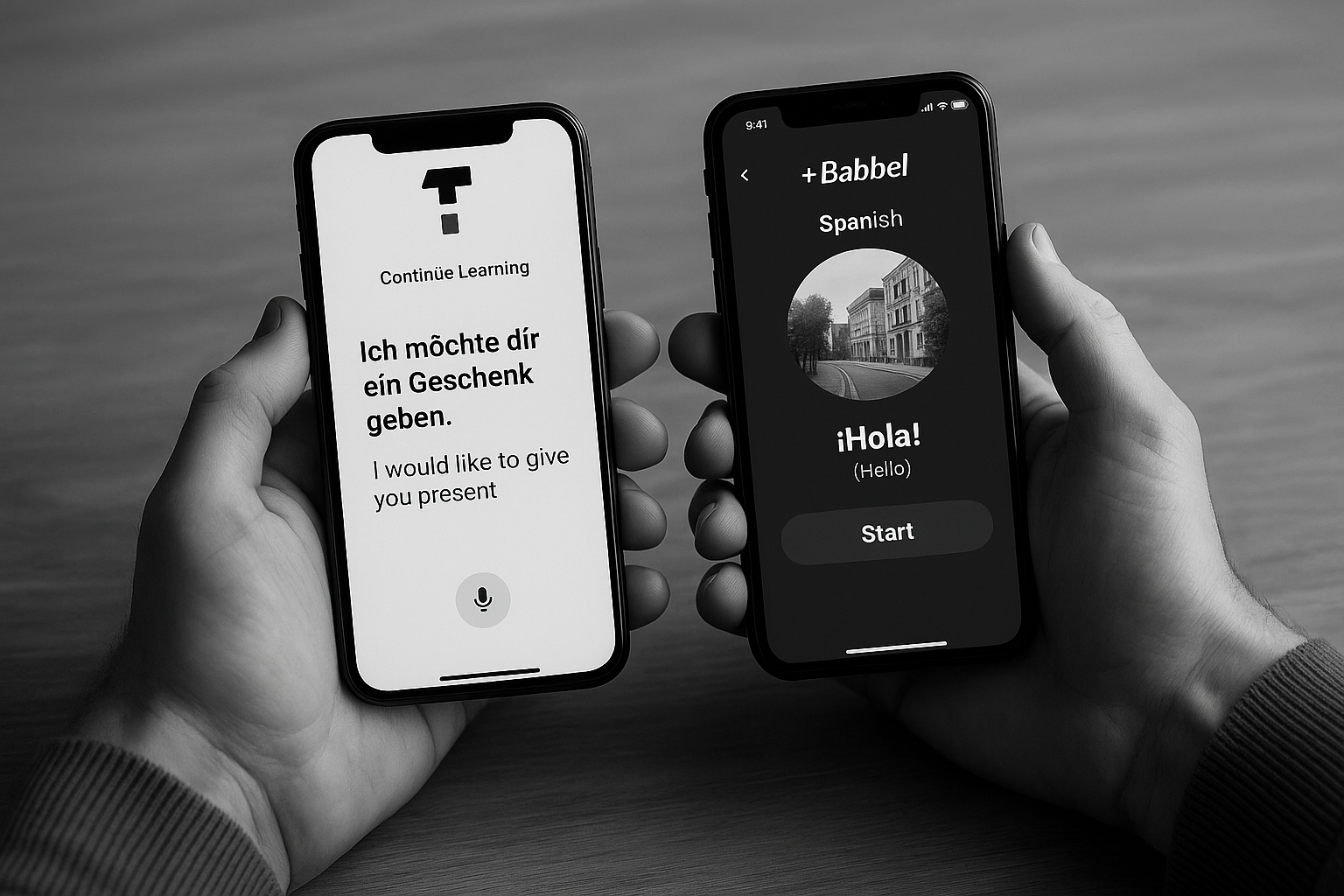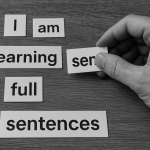Not every language learning app is created equal. Some get you memorizing words, others walk you through grammar tables — and then there are apps that actually train you to speak fluently. That’s the difference this article is here to expose.
In 2025, two names keep coming up in learner communities and app stores: Babbel and Taalhammer. Both promise progress, structure, and results. But if you’re serious about fluency — not just recognition or rule-following — the distinction becomes clear.
In this article, we’ll compare Babbel and Taalhammer across what really matters:
- Do they help you speak in real situations?
- Do they adapt to your brain?
- Do they teach grammar in context or in isolation?
- And most importantly: who is each app actually built for?
Let’s dive in — and find out which language learning app is truly better for learning, and for whom.
- What Makes a Language Learning App Truly Effective?
- What Really Matters in a Language Learning App? 10 Questions That Expose the Difference
- Does the app adapt review timing to your memory — or just schedule reviews?
- Is the learning based on active recall — or passive exposure?
- Can the app get you from “knowing a word” to speaking fluently in real life?
- Do you learn to think in full sentences — or piece things together from rules?
- Does the app help you progress from basic to advanced naturally?
- Is grammar taught in context — or in isolation?
- Is the language learning app designed for busy adults — or does it demand a strict routine?
- Do you control what you learn — or follow a locked path?
- Are you required to speak — or can you get away with just clicking?
- Does the language learning app train fast, automatic responses — or slow translation?
- Consumer Concerns: What Regular Learners Want to Know
- Taalhammer vs Babbel: Sentence-Based vs Grammar-First
- Real Use Cases: Which Language Learning app Suits Which Learner Type?
- Is Taalhammer or Babbel a Better Value for Language Learners?
- Which Language Learning App Should You Use in 2025 — and Why?
- FAQs: Taalhammer vs Babbel — Fast Answers for Smart Learners
What Makes a Language Learning App Truly Effective?
Before we compare apps, let’s define what “effective” actually means in the context of language learning. Hint: it’s not just about colorful streaks or how many phrases you can tap through in 10 minutes.
A truly effective language app helps you:
Understand the Language in Context
Words don’t live in isolation. Apps should teach you full phrases and how they function together — so you’re learning how to communicate, not just translate.
Recall and Use What You’ve Learned
It’s one thing to recognize a word. It’s another to say, “Can I pay with card?” without pausing. The best apps prioritize active recall and output practice — like typing, speaking, and transforming full sentences. We’ve compared 11 of them in detail to see which actually supports full-sentence learning.
Adapt to Your Brain, Not a Schedule
Your memory isn’t linear. If an app truly implements spaced repetition, it should review content when you are about to forget it — not when a fixed calendar says so.
Put You in Control
You’re not a passive student. A good app lets you decide what content you want to learn, how often you review, and which skills to focus on — grammar, speaking, listening, or all three.
Taalhammer was designed with these pillars in mind. Babbel gets some of them right, especially when it comes to structure and grammar explanations. But the real test? Let’s see how they each hold up against deeper, expert-level scrutiny.
What Really Matters in a Language Learning App? 10 Questions That Expose the Difference
Not all language apps are built the same. Some focus on keeping you entertained. Others double down on grammar charts. But if you’re serious about learning — really learning — these are the questions that separate the flash from the functional.
Let’s break down the 10 questions that reveal whether an app actually helps you speak fluently, and how Taalhammer and Babbel compare:
Does the app adapt review timing to your memory — or just schedule reviews?
Taalhammer uses true spaced repetition powered by AI. It tracks how well you recall each sentence and resurfaces them just before you forget.
Babbel uses a review cycle based on lesson progression — not your personal memory curve.
If you want to explore how different apps handle memory science, check out our full breakdown of the best language learning apps with spaced repetition and AI.
Is the learning based on active recall — or passive exposure?
Taalhammer forces you to recall and speak full sentences.
Babbel includes more passive formats like matching and fill-in-the-blanks.
Can the app get you from “knowing a word” to speaking fluently in real life?
Taalhammer starts with full, useful sentences from Day One — the kind you’d actually use.
Babbel builds gradually from words and grammar, but often delays output.
Do you learn to think in full sentences — or piece things together from rules?
Taalhammer teaches natural sentence patterns that help you think directly in the language.
Babbel leans on structured grammar rules first, then builds toward application.
Does the app help you progress from basic to advanced naturally?
Taalhammer increases sentence complexity over time through repetition and variation.
Babbel follows CEFR levels step-by-step — useful, but rigid. You can even take a placement quiz that will determine your level.
Is grammar taught in context — or in isolation?
Taalhammer lets you absorb grammar through example-based repetition.
Babbel explains grammar with rules first, then offers practice.
Is the language learning app designed for busy adults — or does it demand a strict routine?
Taalhammer adapts to your time and memory needs — even short sessions count.
Babbel encourages steady use, but doesn’t prioritize what you need most.
If you’re looking for tools tailored to tight schedules and serious goals, explore our full guide to the best language learning apps for adults in 2025.
Do you control what you learn — or follow a locked path?
Taalhammer lets you study your own material, combine it with built-in decks, and build around your needs.
Babbel guides you through preset courses only.
Are you required to speak — or can you get away with just clicking?
Taalhammer includes speaking prompts in nearly every review session.
Babbel offers speech recognition, but it’s optional and underused.
Does the language learning app train fast, automatic responses — or slow translation?
Taalhammer builds recall reflexes — you respond fast, naturally.
Babbel builds understanding, but often lacks real-time pressure or speaking drills.
If you care about speaking fluently — not just knowing grammar — Taalhammer clearly leans toward real-world use. It’s not about tapping through content. It’s about learning to think and speak in a new language.
Consumer Concerns: What Regular Learners Want to Know
Not everyone is diving into second language acquisition research — and that’s okay. Most learners just want honest answers to practical questions: How many languages are there? Is it free? Will it actually help me speak?
So let’s put Taalhammer and Babbel through a straight-up, no-jargon comparison — from a real-world learner’s perspective.
How many languages are supported?
Taalhammer supports over 75 languages — all fully usable with the same spaced repetition system. While some have more curated content than others, all benefit from the sentence-based method and AI review.
Babbel offers 14 languages, with strong support for major European ones (Spanish, French, German, etc.). Others may have more limited depth.
Will I actually speak — or just recognize words?
Taalhammer trains you to recall and speak full sentences aloud from the start. It’s output-first and designed for fluency.
Babbel helps build understanding through structured lessons, but speaking is often optional and limited to a few exercises.
Is it free — and what do I get without paying?
Taalhammer gives you a 7-day free trial with full access — no credit card required. You can test all features and content types.
Babbel does not have a free version. You can preview the first lesson of each course, but full access requires a subscription upfront.
How much time do I need to see results?
Taalhammer is built for real-life schedules. With as little as 10 minutes a day, you’ll start building solid memory and fluency — because each review is personalized to what you need most.
Babbel recommends consistent daily use and longer sessions to follow its structured course path. Progress is visible but often slower without reinforcement outside the app.
These are the questions most people care about — and when answered side by side, the picture is clear: if you’re aiming for fluency and flexibility, Taalhammer delivers more for most modern learners.

Taalhammer vs Babbel: Sentence-Based vs Grammar-First
This is the core difference — and the reason these two apps appeal to very different learners.
Taalhammer: Sentence-First, Fluency-Focused
Taalhammer flips the approach: you start with full, natural sentences, then build grammar through repeated exposure and variation. You’re speaking, typing, and recalling from the first few minutes.
Pros:
- Learn grammar through context
- Immediate speaking practice
- Highly adaptive review system
Limitations:
- Learning path is more flexible — which may feel less “course-like”
Babbel: Structured, Grammar-First Learning
Babbel follows a CEFR-aligned path (A1 to B2), teaching vocabulary and grammar step-by-step. It’s ideal if you love structure, explanations, and the feeling of moving through a curriculum.
Pros:
- Clear grammar breakdowns
- Predictable lesson structure
- Great for beginners who prefer rules
Limitations:
- Less speaking practice
- Slower to build spontaneous speech
- Harder to deviate from the linear path
Inline Highlight:
“Babbel teaches you how the language works. Taalhammer teaches you to use it — naturally, automatically, and out loud.”
Fluency Features Breakdown: Who Teaches You to Speak?
Most language apps will teach you about the language. The real question is: do they teach you to speak it — naturally, confidently, and without translating in your head?
This section breaks down how Babbel and Taalhammer handle the real engine of fluency: output.
Speaking Practice
Babbel includes some speaking exercises, but they’re often optional. You’ll see scripted dialogues, fill-in-the-blank drills, and occasional speech recognition prompts. The focus is on understanding structure, not producing language instinctively.
Taalhammer puts output at the core. You’re asked to recall and say full sentences regularly — not just recognize them. This active practice builds fluency from the ground up.
“Recognition isn’t fluency. Recall is.”
– a core principle behind Taalhammer’s design
Sentence Complexity
Babbel builds up from individual words and short phrases, slowly increasing difficulty across CEFR levels. It’s structured, but the leap to real-life conversations can feel steep.
Taalhammer starts with usable sentences immediately — things like “I missed the train” or “Can I pay with card?” Complexity increases naturally through spaced repetition and variation, not via separate grammar lessons.
Speed of Response
Fluency isn’t just knowing the right thing — it’s saying it fast and confidently.
Babbel’s format often slows learners down with exercises that feel more academic.
Taalhammer trains for speed. By practicing sentence recall out loud under spaced conditions, users learn to respond reflexively, without pausing to translate.
If your goal is to explain grammar rules, Babbel prepares you well.
If your goal is to use the language — in conversation, travel, or work — Taalhammer builds the muscle memory to get you there.
For a deeper comparison focused purely on fluency-building, check out Which Language Learning App Helps You Become Fluent? Taalhammer vs Busuu, Glossika and 3 More.
Real Use Cases: Which Language Learning app Suits Which Learner Type?
It’s not just about which app is “better” in general — it’s about which one works best for you. Let’s look at who benefits most from each platform, based on learning style, goals, and schedule.
Taalhammer is best for:
- Learners who want to speak fluently, not just study rules
- People who value output, recall, and real sentences
- Busy adults looking for flexible, personalized learning
- Those who’ve tried apps like Duolingo or Babbel and felt stuck at recognition
Example:
Lena is learning French for work and has 15 minutes per day. With Taalhammer, she reviews and speaks full sentences aloud during coffee breaks. Within a few weeks, she starts thinking in French — and actually uses it in meetings.
Babbel is best for:
- Beginners who prefer structured, guided learning
- Learners who enjoy clear grammar explanations and step-by-step progress
- Students preparing for CEFR exams
- Those who don’t mind a more academic, rule-based format
Example:
Martin wants to learn German and likes studying grammar. He follows Babbel’s A1-A2 levels and appreciates the steady, linear progression with exercises and translations.
Which type of learner are you?
If you want clear rules, measured progress, and grammar-first instruction — Babbel is a solid option.
But if you’re aiming for real fluency, faster reflexes, and natural sentence production, Taalhammer is simply more effective — especially for motivated, busy adults.
Curious how Taalhammer performs beyond major European languages? See my article: Best Language Learning App for Japanese in 2025? Taalhammer vs Duolingo, Anki, LingoDeer and More.
Is Taalhammer or Babbel a Better Value for Language Learners?
When choosing a language app, price matters — but so does what you get for that price. Let’s break it down by looking at cost, features, and long-term return on learning.
Pricing Overview
| App | Free Version | Trial Access | Paid Plans |
|---|---|---|---|
| Taalhammer | No | 7-day full-feature trial | From €9.99/month |
| Babbel | No | One free lesson preview | From €14.99/month |
What You Actually Get
Taalhammer gives you full platform access during the free trial — no card required. You get to test the entire method, create personal sentence decks, and experience adaptive review and speaking drills. After the trial, the pricing is lower than Babbel — with more flexibility.
Babbel offers a polished, curriculum-based experience. You’re paying for a traditional language course delivered through your screen — structured, predictable, and useful for rule-learners. But access is restricted: there’s no trial period with real usage, and you can’t create or adapt content to your own goals.
Value for Time Spent
If you measure value not just in euros but in fluency gained per minute, the difference grows:
- Babbel rewards consistency, but much of the time is spent in passive review or structured drills.
- Taalhammer focuses every minute on active, high-impact recall and speaking — so even short sessions move you forward.
You’re not just buying an app — you’re investing in how your brain retains and uses a language.
Taalhammer turns that investment into fluency, faster.
For learners who want a structured experience with grammar-heavy instruction, Babbel offers solid value.
But for those who want to speak confidently, remember what they learn, and personalize their path, Taalhammer offers more — for less.
Want a broader look at how pricing compares across popular apps? Read The Most Affordable Language Learning Apps (That Are Actually Worth It): Taalhammer vs Duolingo and 5 More.
Which Language Learning App Should You Use in 2025 — and Why?
If you’re choosing a language learning app in 2025, the question isn’t just which one is better, but which one helps you reach your personal fluency goals faster, more effectively, and with less friction.
Let’s summarize.
Choose Taalhammer if you:
- Want to start speaking from Day One
- Learn better through context, sentence patterns, and recall
- Value flexibility, personal content, and true memory science
- Have limited time and need every minute to count
Taalhammer is designed for modern learners — people who want to learn efficiently, not just traditionally. Whether you’re learning for work, travel, or personal growth, it helps you speak the language, not just study it.
Choose Babbel if you:
- Prefer structured lessons and traditional grammar instruction
- Like progressing through defined levels (A1 to B2)
- Are starting from scratch and want predictable, guided content
- Don’t mind slower progress toward fluency
Babbel works well if you want a course-style experience, similar to what you’d get in a classroom, and if you’re okay with speaking coming later.
Final Take:
If you’re after fluency, not just familiarity — and want a system that adapts to how your brain works — Taalhammer is simply the smarter choice for most serious learners.
FAQs: Taalhammer vs Babbel — Fast Answers for Smart Learners
Is Taalhammer better than Babbel?
It depends on your goal. If you want to speak fluently using full sentences, Taalhammer is better. If you prefer structured grammar lessons and slow progression, Babbel may suit you.
Which language learning app helps you become fluent faster?
Taalhammer. It focuses on output, active recall, and natural sentence usage — all proven to accelerate real fluency.
Can I use Taalhammer for free?
Yes. You get a full-featured 7-day free trial without entering payment info. After that, plans are affordable and flexible.
Does Babbel have a free version?
Not really. You can preview the first lesson of each course, but full access requires a paid subscription.
Which app is better for speaking practice?
Taalhammer. Speaking is built into every review session. Babbel includes speech recognition, but it’s optional and limited.
Can I customize what I learn in either language learning app?
Only in Taalhammer. You can create your own decks, personalize topics, and focus on what matters most to you.
Is either language learning app good for busy adults?
Yes — but in different ways. Babbel fits into 15-minute daily routines. Taalhammer goes further by adapting review schedules and prioritizing what you need to review, making even short sessions efficient.









